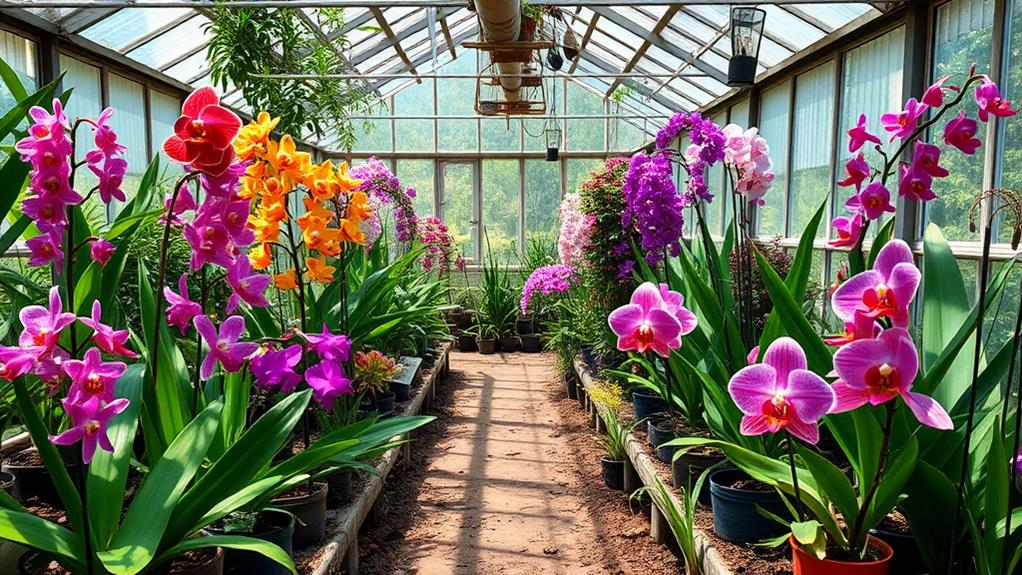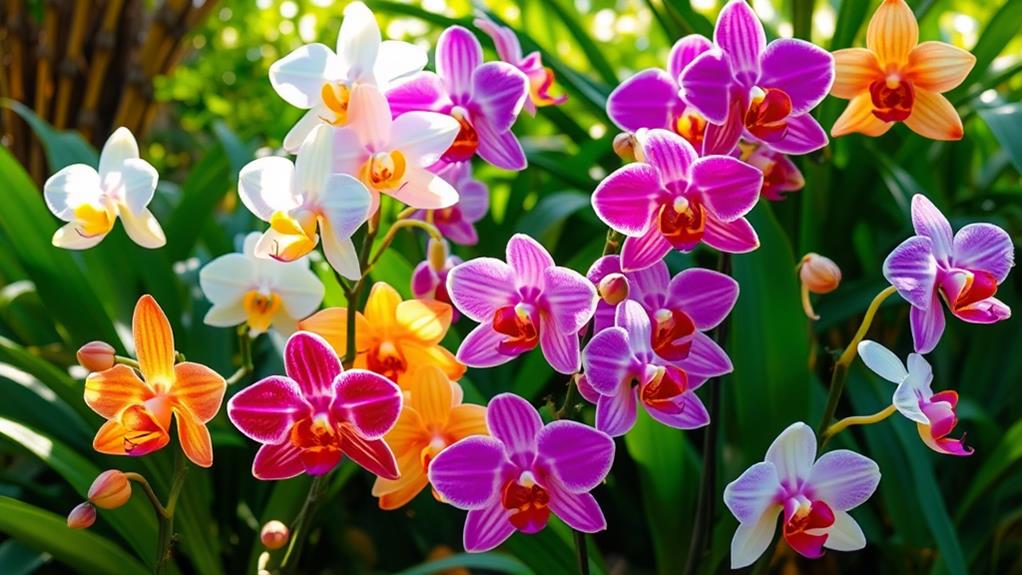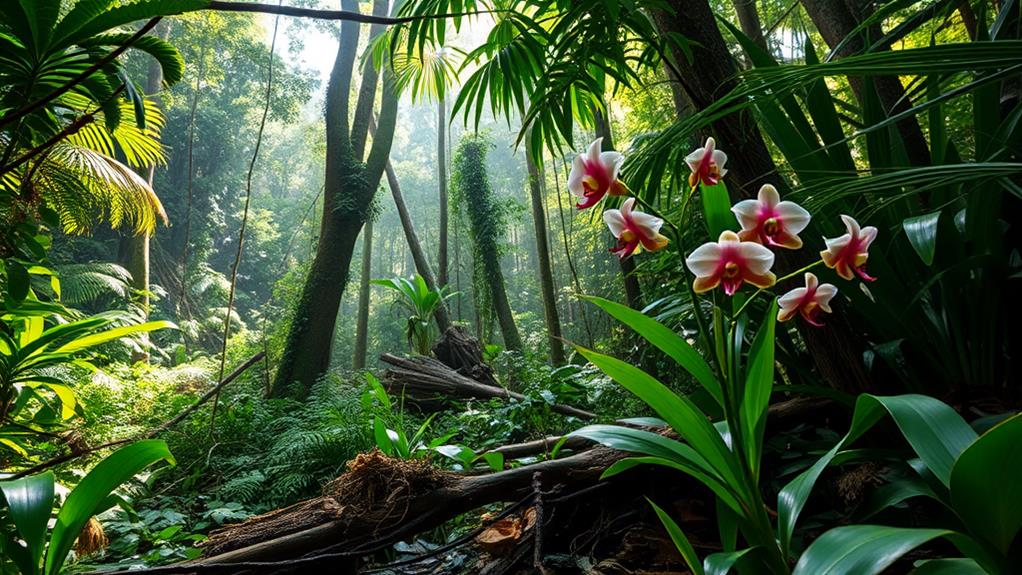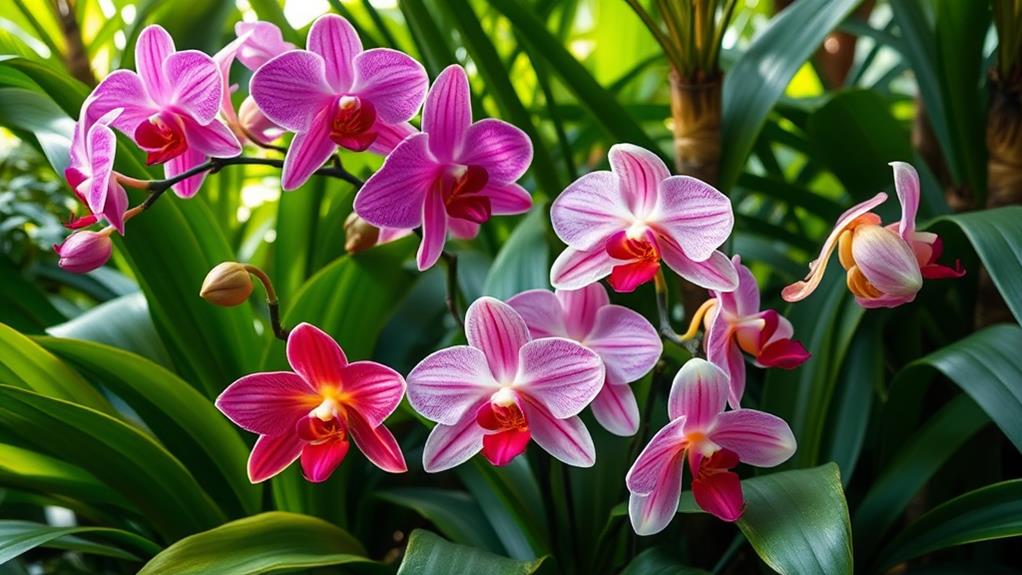Philippine orchids boast an astonishing 1,400 native species, with 90% found only in the Philippines.
This remarkable diversity is exemplified by the iconic Waling-Waling, a symbol of beauty and resilience.
The Waling-Waling is not only a stunning flower but also an important indicator of ecosystem health.
Philippine orchids play a critical role in their ecosystems, providing habitats and food for various wildlife species.
However, their conservation is threatened by habitat loss, illegal collection, and climate change.
To address these threats, education initiatives and community involvement are essential.
By engaging local communities in conservation efforts, we can empower them to protect their natural heritage.
Cultivation techniques for Philippine orchids are intricate and require great skill.
For instance, the Waling-Waling requires a specific combination of temperature, humidity, and light to thrive.
Understanding these techniques is crucial for their conservation.
Philippine orchids also hold significant social importance, with many species playing important roles in traditional medicine and cultural ceremonies.
By exploring the connections between culture and conservation, we can gain a deeper appreciation for the importance of preserving this floral heritage.
Overview of Philippine Orchids

Philippine Orchids: Unique Biodiversity and Cultural Significance
Philippine orchids are one of the most diverse and captivating groups of flowering plants in the world. With over 1,400 native species, around 90% of these orchids are endemic to the archipelago, showcasing significant orchid diversity unique to this region. The Philippines is also home to the world’s largest flower, the Rafflesia arnoldii, which can grow up to three feet in diameter. In addition to its impressive orchid and floral diversity, the Philippines also has a rich cultural history and tradition of using orchids for ornamental and medicinal purposes. The country’s orchid gardens and festivals, such as the Baguio Orchidarium and the Orchid Festival in Davao City, attract visitors from around the world who are captivated by the beauty and diversity of these unique plants.
The Waling-Waling (Vanda sanderiana) is a prime example, not only contributing to the visual allure but also holding deep cultural significance as the national flower, symbolizing love, beauty, and strength in Filipino culture.
Orchid Cultivation and Its Impact
Orchid cultivation is integral to local economies, providing livelihoods through ornamental horticulture. The increasing demand for these exquisite flowers enhances both economic opportunities and environmental awareness.
However, the survival of these endemic orchids is jeopardized by threats such as habitat loss, illegal collection, and climate change.
Conservation Efforts
Conservation efforts are vital to protect this extraordinary biodiversity. By supporting initiatives aimed at preserving these unique species, you play a role in safeguarding not only the orchids but also the cultural heritage they represent.
Unique Orchid Species
The Philippines is home to over 1,400 native orchid species, with approximately 90% being endemic, meaning they can only be found in the Philippines.
Among these unique orchid species, Dendrobium taurinum is an example of strength and perseverance, while Phalaenopsis deliciosa showcases modest beauty.
The Aerides lawrenceae is celebrated for its elegant appearance and is featured on postage stamps, symbolizing purity and elegance in Filipino culture.
Similarly, the Thrixspermum subulatum features star-shaped flowers that reflect national aspirations and Filipino identity.
Many of these endemic orchid species, such as Dendrobium butchcamposii and Dendrochilum mindanaense, are critically endangered.
This highlights the urgent need for conservation efforts to protect not only biodiversity but also the cultural heritage tied to these unique orchids, similar to the endangered Philippine tamaraw.
Cultivation Techniques

Orchid Lighting Requirements
Orchids thrive in bright, indirect light. To provide optimal light conditions, place them near east or west-facing windows. This ensures they receive the necessary light without being exposed to direct sunlight, which can cause damage.
Watering Techniques
Proper watering is crucial for orchid cultivation. Water thoroughly only when the potting medium is dry, as this prevents waterlogging and root rot.
Avoid watering on a schedule; instead, check the potting medium daily to determine the best time to water.
Maintaining Humidity
High humidity levels, between 40-70%, are essential for most orchid species. To achieve this, mist the plants regularly or use a humidity tray.
This creates an environment that supports healthy growth and prevents dryness.
Potting Medium Selection
A well-draining potting medium is vital for orchid cultivation. A mix of bark, sphagnum moss, and perlite creates an ideal environment that supports healthy root systems while preventing stagnant water.
Fertilization
Regular fertilization promotes vibrant blooms and robust growth. Fertilize your orchids every two weeks during the growing season with a balanced orchid-specific fertilizer.
This provides the necessary nutrients for optimal growth and flowering.
Cultural Significance
Orchids hold a profound place in Filipino culture, symbolizing purity, resilience, and hope. This significance extends beyond mere aesthetics, representing a vital aspect of the nation's cultural heritage. The Waling-Waling, recognized as the national flower, exemplifies this deep-rooted connection, embodying the richness of the Philippines' floral diversity.
Orchids play a crucial role in Filipino weddings and festivals, serving as key elements in floral arrangements that signify devotion and good fortune. Each native orchid species carries unique meanings, reflecting the values and history of the Filipino people. For instance, the presence of specific orchids at significant life events, such as weddings, fosters a sense of community and shared identity.
The Dendrobium orchid, for example, symbolizes love and longevity.
Orchids are cultural ambassadors, raising awareness about biodiversity while promoting national pride. This is evident in their portrayal on stamps.
Unfortunately, many of these beautiful species, including some orchids, face the threat of extinction. Understanding their cultural significance can catalyze conservation efforts, ensuring that future generations appreciate these endangered orchids not just for their beauty but as symbols of resilience and hope in Filipino culture.
Symbolism of Orchids

Orchids in Filipino Culture: A Symbol of Deep-Rooted Values
The symbolism of orchids in Filipino culture embodies a rich tapestry of meanings, reflecting deep-rooted values and beliefs.
In the Philippines, orchids symbolize love, beauty, and strength, with specific meanings tied to individual species.
White Orchids: Purity and New Beginnings
White orchids signify purity and new beginnings. This symbolism is rooted in the Filipino tradition of valuing innocence and fresh starts.
Vibrant Colors: Resilience and Adaptability
Orchids with vibrant colors represent resilience and adaptability, reflecting the Filipino spirit's ability to thrive in challenging circumstances.
The Bull Orchid: Power and Determination
The Bull Orchid, with its unique spiraling petals, epitomizes power and determination. This resonates with the struggles and triumphs of the Filipino people, showcasing their unwavering resolve.
Orchids as Cultural Ambassadors
Native orchid species, such as Aerides lawrenceae and Dendrobium taurinum, are featured in artistic representations and stamps, promoting national pride and raising awareness about biodiversity.
These cultural ambassadors highlight the importance of preserving the Philippines' rich natural heritage.
Symbolic Interpretations in Art and Culture
Each orchid species depicted in art and culture carries specific symbolic interpretations.
For example, the Waling-Waling orchid represents rarity and uniqueness, while the Pink Vandaceous orchid symbolizes love and beauty.
These interpretations enhance appreciation for the Philippines' natural heritage, linking Filipino values, history, and environmental consciousness.
Environmental Importance
Philippine orchids are vital components of their ecosystems, providing essential habitats and food sources for various wildlife species. For example, the Kapangan orchid serves as a vital food source for the Philippine cockatoo, a critically endangered species. This interaction fosters ecological balance, crucial for maintaining vibrant ecosystems.
Orchids act as indicators of environmental health, reflecting the stability and quality of their habitats. When you observe thriving orchid populations, it signals a healthy ecosystem. Conversely, declining orchid populations can indicate habitat destruction, pollution, or climate change.
Philippine orchids play a pivotal role in pollination, aiding in the reproduction of many plant species. For instance, the Paphiopedilum orchid relies on specific bees for pollination, ensuring the continuation of its species. This process is essential for ecosystem sustainability, as it ensures a continuous cycle of plant life.
Orchids contribute to the overall resilience of their environments, helping to mitigate the impacts of climate change. By recognizing their environmental importance, we can better appreciate their role in preserving our planet's health and diversity.
This understanding encourages more people to engage in orchid conservation efforts, promoting ecotourism and environmental appreciation.
Conservation Challenges

Philippine orchids face numerous conservation challenges that threaten their survival. The main threat is habitat loss, which is exacerbated by human activities such as land encroachment and slash-and-burn farming. These activities destroy the natural habitats essential for the growth of the over 1,400 native species, 90% of which are endemic.
The lack of government initiatives specifically aimed at orchid conservation is a critical challenge. Although the CITES program exists, there's a need for comprehensive strategies for the rescue and rehabilitation of confiscated orchids.
This lack of strategy leaves many endangered species without the protection they need.
Successful conservation efforts in other Asian countries have shown the importance of creating tailored strategies that focus on local needs. For example, establishing protected areas and fostering community involvement are key to reversing the decline of these unique orchids.
Education and awareness programs are vital to combat illegal activities impacting orchids and to enforce wildlife protection laws.
Without a concerted effort, the rich diversity of Philippine orchids risks disappearing forever. It's essential to address the conservation challenges facing these orchids to ensure their survival.
Initiatives for Preservation
Preservation Initiatives for Philippine Orchids
To address the conservation challenges faced by Philippine orchids, a multi-faceted approach is necessary.
One effective strategy is the Philippine Orchid Society's annual show, which focuses on "Protecting Orchid Species from Climate Change." This event not only showcases stunning orchids in the Philippines but also raises awareness about the urgent need for conservation efforts.
Education programs play a critical role in increasing public knowledge about the threats faced by these threatened species. For instance, informing communities about the importance of orchids and their ecosystems fosters a sense of responsibility and involvement.
Collaboration with botanical institutions further enhances preservation efforts through research and propagation, ensuring that threatened species have a fighting chance.
Enforcing Wildlife Protection Laws is crucial to combat illegal collection and habitat destruction, which pose significant risks to the country's endemic orchids.
Encouraging community engagement in orchid rehabilitation and propagation empowers local populations. This not only enhances biodiversity but also promotes sustainable economic practices related to orchid cultivation, allowing communities to thrive while protecting their natural heritage.
Community Involvement

Community involvement is crucial for conserving Philippine orchids. Local engagement empowers grassroots efforts and instills a sense of ownership over biodiversity.
For instance, the Philippine Orchid Society's annual show serves as a platform for education, featuring landscape exhibits, workshops, and lectures that raise public awareness about conservation.
Training programs equip community members with essential skills. These programs focus on the propagation and care of endangered orchids, fostering effective conservation practices.
By utilizing social media, communities can share their initiatives, attracting a wider audience and increasing public interest in conservation efforts.
Collaborations with educational institutions strengthen community involvement. Integrating orchid conservation into curricula encourages research that benefits both students and local ecosystems.
For example, by fostering these relationships, a network of informed advocates is created, championing the cause of orchid preservation and ensuring that future generations appreciate the Philippines' unique biodiversity.
Research and Findings
Research and Findings
Philippine Orchid Diversity and Conservation Status
A recent study in Mt. Malindang revealed 114 orchid species, with 55 classified as endemic to the region. This highlights the Philippines' rich biodiversity, particularly in montane and mossy forest ecosystems, where the research found the highest species richness.
Endangered Species and Conservation Efforts
The study identified three orchid species listed under Appendix I of CITES, marking them as globally endangered. In contrast, 78 species fell under Appendix II, which allows for controlled trade.
These findings emphasize the urgent need for effective protection plans, especially in habitats where endangered species reside.
Global Biodiversity Databases and Conservation Strategies
The research contributes significantly to global biodiversity databases, enhancing our understanding of orchid diversity in the Philippines.
Targeted conservation actions can be informed by these findings, ensuring the preservation of these unique orchids and their habitats.
Endemic Species Highlights

The Philippines is home to over 1,400 native orchid species, with approximately 90% found nowhere else on Earth.
These endemic orchids highlight the nation's unique biodiversity and the intricate relationships within their natural habitats.
The country's ecological significance is underscored by these species.
Some notable endemic orchids include:
_Appendicula malindangensis_ is a rare species found only in the montane forests of Mt. Malindang.
_Ceratostylis pristina_ is known for its distinctive morphology, contributing to the region's biological diversity.
_Dendrobium butchcamposii_ is a striking example of the unique adaptations found in local orchids.
_P. hennisianum_ and _P. haynaldianum_ are both classified as globally endangered, emphasizing the urgent need for conservation efforts.
Mt. Malindang's montane forest exhibits the highest species richness among various forest types.
Documenting these endemic species is vital for understanding regional biodiversity and informing conservation strategies.
These efforts are crucial for the survival of these unique orchids, ensuring their beauty and ecological roles endure for future generations.
Future of Orchid Conservation
Conservation of the Philippines' Unique Orchids is Crucial
The Philippines is home to approximately 1,400 native orchid species, with 90% being endemic, making conservation efforts essential to protect these unique species. The main threats to their survival are habitat loss, natural disasters, and human activities.
Education is Key to Raising Awareness
Effective conservation strategies must prioritize education programs to raise awareness about the significance of these orchid species. By educating the public, we can encourage responsible behavior and promote the protection of orchid habitats.
Enforcing Wildlife Protection Laws is Vital
Wildlife Protection Laws must be enforced to combat illegal activities that jeopardize the existence of these species. This will help prevent the destruction of their habitats and ensure their survival.
Collaboration with Botanical Institutions is Necessary
Collaborating with botanical institutions is crucial for research and propagation to safeguard endangered orchids and restore their natural habitats.
This partnership can facilitate the development of techniques for sustainable cultivation, supporting local economies while meeting global demand for Philippine orchids.
Community Engagement is Essential
Community engagement plays a vital role in conservation efforts.
Initiatives like the Philippine Orchid Society's annual show not only focus on climate change impacts but also promote local participation in conservation efforts.
This encourages community involvement and raises awareness about the importance of orchid conservation.
A Multifaceted Approach is Necessary
Ultimately, the future of orchid conservation hinges on a multifaceted approach that combines education, legal enforcement, research, and community involvement to ensure these remarkable species can thrive for generations to come.
Questions and Answers
What Does the Orchid Symbolize in the Philippines?
In Filipino culture, orchids represent love, beauty, and strength. The meaning of orchids varies depending on their color and type.
White orchids symbolize purity and new beginnings, while vibrant varieties signify resilience.
The Waling-Waling, the national flower of the Philippines, embodies national pride and prosperity.
The rich symbolism of orchids reflects the deep emotional connections and cultural values of the Filipino people, making them an integral part of celebrations and ceremonies.
What Is the Biodiversity of Orchids?
Orchid biodiversity is incredibly diverse, with over 30,000 species spread across various habitats.
These habitats, including montane forests, wetlands, and grasslands, provide distinct ecological niches that support the unique pollination strategies of orchids.
Conservation efforts are essential to protect orchids from threats like habitat loss and climate change.
Many species face extinction due to these factors, highlighting the need for sustainable practices to preserve these remarkable plants.
Understanding orchid biodiversity allows us to appreciate the intricate relationships between orchids and their environments.
For example, some orchids rely on specific insects for pollination, while others have adapted to self-pollination.
What South American Country Has the Greatest Diversity of Orchids?
Ecuador is the South American country with the greatest diversity of orchids, boasting over 4,000 species. This remarkable range is supported by varied ecosystems, including Andean habitats and tropical rainforests, which enable unique orchid cultivation practices.
For example, the orchids in the Andean ecosystems have adapted to the high-altitude conditions, while those in the tropical rainforests thrive in the hot and humid environment.
However, the diversity of orchids in Ecuador is threatened by habitat loss and climate change, highlighting the importance of orchid conservation.
One way to support conservation efforts is by engaging in sustainable tourism, which can help protect these precious orchid species for future generations.
What Is the Cultural Significance of the Orchid?
Orchids hold a profound cultural significance that transcends their beauty, intertwining with folklore and traditional uses across various societies.
They symbolize beauty, love, and resilience, often taking center stage in cultural festivals. For instance, in Japan, orchids are celebrated during the annual Orchid Festival, where they're showcased in elaborate displays and arrangements.
In China, they're a symbol of fertility and abundance, with the orchid flower being one of the "Four Gentlemen" in Chinese art and literature.
Their unique shapes and vibrant colors have inspired artistic expression, with many artists using orchids as a canvas for their creativity. The intricate patterns and shapes of orchids have also inspired architectural designs, such as the iconic Singapore National Orchid Garden.
In many cultures, orchids also play a significant role in traditional medicine, with various species being used to treat ailments ranging from fever to skin conditions.
For example, the Dendrobium orchid is used in traditional Chinese medicine to treat coughs and fever.
This multifaceted importance of orchids showcases their profound impact on cultural identity and heritage, reflecting their significance in various aspects of human life.